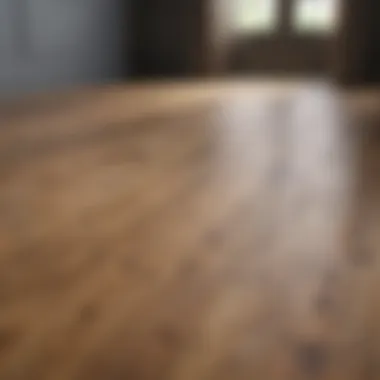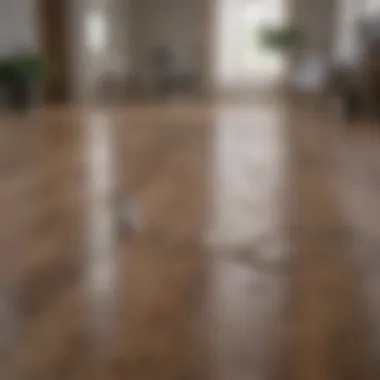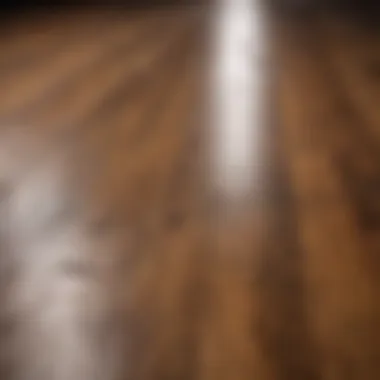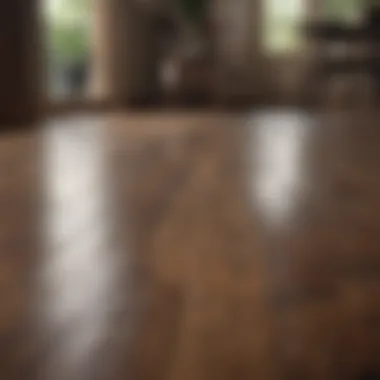Expert Tips for Cleaning Wooden Floors


Intro
Cleaning wooden floors effectively is a crucial aspect of home maintenance that goes beyond mere aesthetics. Many homeowners and design enthusiasts often overlook the specific requirements needed for proper care of wooden surfaces. Each type of wood, its finish, and the environment where it is placed can influence the cleaning method used. A well-informed approach to cleaning can help maintain the integrity and beauty of wooden floors over time.
In this guide, we will explore the necessary components for maintaining wooden flooring, which includes identifying suitable cleaning agents, effective techniques, and the right tools. Additionally, we will delve into routine cleaning practices, strategies for managing stains, and tips on preserving the elegance of wood.
This article aims to equip readers with a comprehensive understanding of how to care for wooden floors, ensuring that they retain their charm and functionality for many years.
Understanding Wooden Flooring
Wooden floors are a significant investment for many homeowners. Understanding their unique characteristics is vital for proper maintenance and can extend the life of the flooring. Variations in wood species, finishes, and environmental factors all play essential roles in how wooden floors should be cleaned and cared for. Grasping these elements ensures you make informed choices regarding cleaning products and techniques, which can greatly impact the appearance and longevity of your flooring.
Types of Wooden Flooring
There are primarily two categories of wooden flooring: solid and engineered.
- Solid hardwood floors are made from a single piece of wood. This type is known for durability and can be sanded and refinished multiple times throughout its life. Common species include oak, maple, and cherry.
- Engineered hardwood consists of multiple layers of wood, with a veneer layer on the top. This construction gives engineered floors more stability in fluctuating temperatures and humidity. It cannot withstand sanding and refinishing as efficiently as solid hardwood.
Choosing the right type of wooden flooring depends on the specific needs of your home and your personal preferences. Solid hardwood may be ideal for high-end aesthetics, while engineered hardwood suits areas with moisture exposure.
Finishes and Their Impact on Cleaning
The finish of wooden flooring can greatly influence its cleaning requirements. There are several types of finishes, each affecting how you approach cleaning:
- Oil-based finishes penetrate the wood and provide a natural look. While they enhance grain visibility, they require specific cleaning solutions that ensure they do not strip away the natural oils.
- Water-based finishes sit on the surface and dry clear, creating a hard protective layer. Cleaning these floors is often easier, as they can withstand a wider variety of cleaners without causing damage.
- Wax finishes provide a distinct aesthetic but can be challenging to maintain. Regular re-waxing is necessary to maintain their look, and care must be taken to use products compatible with wax.
Proper understanding of your floor's finish is critical. Using the wrong cleaner can lead to dullness or even permanent damage.
Preparing for the Cleaning Process
Cleaning wooden floors is not a simple chore. To do it well, homeowners must prepare adequately. This preparation sets a strong foundation for effective cleaning. It minimizes the chance of damage and ensures the results meet expectations. Failing to prepare can lead to ineffective cleaning and potential harm to the wood, undermining its longevity and aesthetic appeal.
Gathering Necessary Supplies
Before any cleaning can begin, specific materials are necessary. Appropriate supplies not only optimize the cleaning process but also safeguard the floors. Here’s a list of essential items:
- Broom or Vacuum: For dusting off dirt and debris. A vacuum should ideally have a hardwood setting to prevent scratches.
- Microfiber Mop: This prevents excess water damage while effectively picking up dust.
- pH-neutral Cleaner: Choose cleaners developed specifically for wooden floors. Avoid abrasive or harsh chemicals that can damage finishes.
- Soft Cloths: These are ideal for spot cleaning and preventing streaks.
- Bucket: If using a mop, ensure you have a bucket to dilute cleaners.
Taking time to gather these supplies improves effectiveness and efficiency. It also reduces frustration during the actual cleaning process.
Assessing Floor Condition
Understanding the condition of your wooden floor is pivotal. Assessing it helps inform the cleaning strategy. Check for the following:
- Scratches and Dents: Identify areas needing special attention. They might require different techniques or products.
- Finish Status: Determine if the wood finish is intact or wearing off. An old finish may not respond well to standard cleaning techniques.
- Dirt Accumulation: A clean, well-maintained floor may require less rigorous cleaning than one that has accumulated grime.


Regular assessments can prolong the life of the floor and help prevent more costly repairs or refinishing.
Removing Furniture and Debris
This step is crucial for effective cleaning. Clearing the space allows full access to the wooden floor, ensuring thorough cleaning. It's important to:
- Move Smaller Items: Start with small furniture or decorations. This includes rugs and chairs. Be gentle to prevent scratches on the floor when moving.
- Take Care with Larger Items: For heavier furniture, use furniture sliders or a dolly. This aids in moving without damaging the floor surface.
- Clear Out Debris: Dust, dirt or pet hair can build over time. Tidy up the area to create a clean environment for cleaning.
Remember: Always lift rather than drag heavy furniture to avoid scratching or scuffing the wood.
By preparing well for the cleaning process, homeowners ensure that they can maintain their wooden floors properly. Underestimating this phase can lead to subpar results and possible damage, making future cleaning more difficult.
Routine Cleaning Techniques
Cleaning wooden floors is not just about addressing stains or spills; it involves a consistent and methodical approach to care. Routine cleaning techniques are crucial in preserving the luster and extending the lifespan of wooden flooring. By engaging in these techniques, you maintain a hygienic environment while reducing the risk of wear and tear.
Regular cleaning helps to eliminate dirt, dust, and allergens that can damage the finish and surface of the wood. It is preferable to adopt a cleaning regimen that does not only clean but also showcases the natural beauty of wooden flooring. Therefore, understanding how to execute routine cleaning is paramount for homeowners and design enthusiasts alike.
Dry Dusting Methods
Dry dusting is a fundamental step in maintaining wooden floors. It removes loose dust and dirt without introducing moisture. One effective method is using a microfiber cloth or a dust mop. Microfiber material is designed to trap particles effectively, ensuring a cleaner surface.
Here are some key points to consider:
- Frequency: Aim for daily or every few days, especially in areas with high foot traffic.
- Technique: Use gentle, sweeping motions rather than scrubbing to avoid scratches.
- Avoidance: Steer clear of traditional brooms that can scatter dust instead of collecting it.
Mopping with Appropriate Solutions
Mopping is an essential component of the routine cleaning process. However, it is critical to use the right solutions to preserve the finish of the wood. Water should be used sparingly to prevent swelling or warping.
Select a cleaner specifically formulated for wooden floors. Avoid harsh chemicals such as bleach or ammonia, which can deteriorate the wood. Consider the following:
- Solution selection: Opt for a pH-balanced cleaner that is safe for your floor’s finish.
- Tools: Use a damp mop rather than a soaking wet one. This minimizes moisture.
- Technique: Mop in the direction of the wood grain to avoid creating streaks.
Utilizing Specialty Cleaners
Specialty cleaners are designed to target specific conditions or finishes of wooden floors. These products can be advantageous for certain scenarios, like heavy grime or particular finishes that require unique care.
Consider using the following when necessary:
- Oil-based cleaners: These can nourish the wood and enhance its natural shine.
- Stain removers: Target stubborn stains without harming the underlying material.
- Refresher products: This type can revive dull finishes between deep cleanings.
"Regular maintenance, when approached correctly, can preserve the beauty of wooden floors and contribute to their longevity."
By implementing these methods into your routine cleaning practices, you ensure that your wooden floors remain stunning and in excellent condition. Consistent attention to cleaning not only maintains aesthetics but also enhances the structural integrity of the flooring.
Managing Tough Stains
Tough stains on wooden floors present a significant challenge for homeowners. Unlike other surfaces, wood can become damaged if the wrong cleaning methods are employed. It’s essential to understand the nature and source of stains to tackle them effectively. Addressing stains properly not only improves the aesthetic appeal but also extends the lifespan of the flooring. A strong focus on stain management can significantly aid in preserving the natural beauty and integrity of wooden floors.


Identifying Common Stain Types
Various stains can affect wooden floors, each requiring a unique approach. Common types include:
- Water Stains: These can appear as cloudy patches and often occur when moisture seeps into the wood.
- Oil-Based Stains: Spills from cooking oils or lotions can penetrate the finish, leaving greasy marks.
- Ink Stains: Marks from pens or markers are often deeply embedded and can be hard to remove.
- Pet Urine: This type of stain can not only discolor the wood but also produce unpleasant odors.
Understanding these stain types is crucial as it informs the subsequent cleaning techniques.
Spot Treatment Techniques
Once the stains are identified, spot treatment methods can be employed. Here are some techniques:
- Water Stains: To address water stains, mix equal parts of white vinegar and olive oil. Apply it gently with a soft cloth, rubbing with the grain of the wood.
- Oil-Based Stains: Use a mixture of baking soda and water to form a paste. Apply it to the stained area and gently scrub with a soft cloth.
- Ink Stains: A cotton ball soaked in rubbing alcohol can be effective. Dab it gently on the stain, avoiding excessive rubbing that could damage the finish.
- Pet Urine: First, clean the area with mild soap and water. Follow up with an enzymatic cleaner designed to neutralize odors and break down uric acid.
Always test any cleaning method on a small, inconspicuous area before proceeding to ensure no adverse effects occur to the finish.
When to Seek Professional Help
While many stains can be treated at home, some situations may necessitate professional intervention. Consider this option when:
- The stain is extensive and involves larger areas than typical spot treatment can address.
- You are unsure about the best method for a specific stain type, especially older and more stubborn stains.
- The finish of the floor is damaged or worn, possibly requiring refinishing.
- DIY attempts have failed, possibly causing further damage.
In such cases, it’s prudent to consult with professionals who specialize in floor care. They possess the necessary expertise and equipment to restore your wooden floors effectively.
Long-term Maintenance of Wooden Floors
Maintaining wooden floors is critical for preserving their aesthetic appeal and structural integrity. Over time, wear and tear can significantly diminish the beauty of wood, making regular maintenance essential. A well-maintained floor not only enhances the appearance of a home but also increases the flooring’s lifespan. This prolongs the investment you made in these floors, translating into long-term financial benefits.
To achieve long-term maintenance, homeowners must consider several core elements, including routine schedules, protective finishes, and climate control. Each aspect works in tandem to ensure that the wood remains in optimal condition regardless of external environmental factors.
Routine Maintenance Schedules
Establishing a routine maintenance schedule is critical. It allows for systematic cleaning and care, preventing dirt and grime accumulation.
- Weekly Cleaning: Involves dry dusting or sweeping to remove loose dirt and debris. A microfiber mop can be effective in trapping dust without scratching the floor.
- Monthly Refresher: Each month, a more thorough cleaning should be conducted. This might include mopping with a solution designed for wooden floors, ensuring that no excess water is used.
- Annual Deep Cleaning: Once a year, a deep clean might be needed. This could involve using specialized cleaners that effectively penetrate and clean the wood without damaging it.
Following these schedules keeps floors looking new and minimizes the risk of requiring more intensive repairs.
Applying Protective Finishes
Protective finishes are imperative to safeguard wooden floors from everyday wear. Floors can be treated with various types of finishes that can provide a barrier against scratches and stains.
- Polyurethane: This synthetic finish forms a hard protective layer. It is available in either oil-based or water-based variants, each with its own drying time and odor profile.
- Wax: A more traditional option, wax provides a soft sheen but requires regular reapplication.
- Oil: Oil-based products can nourish the wood while providing protection, making the grain more visible. However, they often necessitate more frequent renewals compared to other finishes.
Applying these finishes periodically helps to restore and maintain shine and protects against longer-term damage.
Humidity and Temperature Control


Humidity and temperature play a significant role in the health of wooden floors. Wood is a natural product that can expand and contract based on moisture levels in the air.
- Optimal Humidity Levels: Ideally, humidity should be maintained between 30% and 50%. Using a humidifier or dehumidifier can help balance this level.
- Temperature Stability: Keeping indoor temperatures stable, ideally between 60°F to 80°F, can prevent excessive movement in the wood. Fluctuations can lead to gaps, cracking, or warping of the flooring.
Regulating these environmental factors contributes significantly to the longevity and stability of wooden floors, ensuring they remain beautiful for years to come.
"Regular maintenance, protective finishes, and climate control are essential components of long-term care for wooden floors."
Specific Circumstances to Consider
Cleaning wooden floors involves various specific circumstances that can greatly influence the methods and products used. Factors such as renovations, presence of pets, and seasonal changes require attention. Each scenario has distinct requirements that ensure the longevity and aesthetics of the flooring. Understanding these circumstances fosters better decision-making in cleaning approaches.
Cleaning After Renovations
Renovations can be exciting but often leave a trail of dust, debris, and potential damage to wooden floors. After renovations, the first step is to assess the floor’s condition. Sanding and refinishing may be necessary. When cleaning, avoid using too much water as it can seep into the wood and cause warping. Use a vacuum to remove debris, then employ a damp mop with a gentle cleaning solution meant for wood. This method effectively removes dust without harming the finish. Keeping the floors protected with drop cloths during the renovation can provide an additional layer of protection.
Pets and Wooden Floors
Pets can present unique challenges for maintaining wooden floors. Scratches and stains from paws or accidents may occur regularly. Owners should consider using area rugs to protect high-traffic zones. Regular vacuuming or sweeping is crucial to remove fur and dirt. For cleaning, a solution specifically designed for pet stains can be beneficial. This reduces odors and the chances of deeper stains. Establishing designated areas for pets can also minimize potential damage to the flooring.
Seasonal Cleaning Considerations
Seasonal changes impact cleaning needs. In winter, salt and moisture can cause damage. It's essential to sweep or vacuum regularly to prevent corrosion. In summer, increased humidity levels can cause wood to expand. A dehumidifier may be advisable to maintain a stable environment. Spring is also an excellent time for deeper cleaning, including polishing the floors. Each season requires a mindful approach to cleaning that preserves the integrity of wooden floors.
"Proper care and maintenance of wooden floors hinge on understanding the specific environmental factors affecting them. Tailoring your cleaning strategy to these nuances ensures your floors remain beautiful and last long."
Adapting cleaning methods to each specific circumstance enhances overall care for wooden surfaces. It prevents damage and maintains their natural beauty. Homeowners should remain attentive to these unique factors for optimal wooden floor maintenance.
Final Considerations
Cleaning wooden floors goes beyond just occasionally mopping or applying special cleaners. It requires a thorough understanding of the materials involved and a commitment to ongoing care. This section emphasizes why these final considerations are crucial to preserving the beauty and integrity of wooden flooring.
One significant element to focus on is the evaluation of cleaning effectiveness. It is not enough to simply follow a cleaning routine; one must regularly assess whether these methods yield the desired results. Evaluating effectiveness can involve checking for any residual dirt, ensuring no scratches are present, and monitoring the sheen of the floor. By performing evaluations periodically, homeowners can adjust their cleaning strategies and choose better products if needed. It helps in identifying any potential problems early, preventing long-term damage.
"Regular assessment of floor condition is essential for maintaining its beauty and longevity."
In terms of benefits, a meticulous approach often translates into increased durability for wooden floors. This proactive method allows for adjustments tailored to specific types of finishes or wood species. A long-lasting shine not only enhances aesthetic appeal but also proves to the observer that the floating surface has been cared for with diligence.
Evaluating Cleaning Effectiveness
Evaluating the cleaning processes used on wooden floors ensures that the efforts put into care are indeed fruitful. This entails simple yet systematic checks.
- Visual Assessment: Inspect the floor for any visible dust or streaks. A clean floor should have a uniform shine with no residual materials.
- Touch Test: Run your hand across the surface. The finish should feel smooth and not sticky or gritty, which indicates proper cleaning.
- Reflective Check: Observe how light interacts with the floor’s surface. A well-cleaned floor should reflect light effectively, showcasing its finish.
If the results are not satisfactory, it may signal a need to reconsider the cleaning techniques or the products used. This can prevent both long-term damage and maintenance inefficiencies.
Continuous Education on Flooring Care
Homeowners should approach wooden floor care as an ongoing learning journey. The world of cleaning agents and techniques constantly evolves. Keeping abreast of new products and methods can significantly impact the longevity of wooden floors.
- Stay Updated: Follow industry blogs or forums like Reddit for the latest insights into flooring care.
- Work with Professionals: Consulting with cleaning specialists can provide tailored advice suited for specific wooden finishes.
- Experiment Cautiously: Trying new cleaning products on a small, inconspicuous area of the floor can help gauge their effectiveness without risking the entire surface.
Investing time in understanding maintenance best practices not only protects the flooring but also enhances its visual appeal. Continuous education is an integral element in successful wooden floor cleaning, ensuring that beauty and condition last for years.















